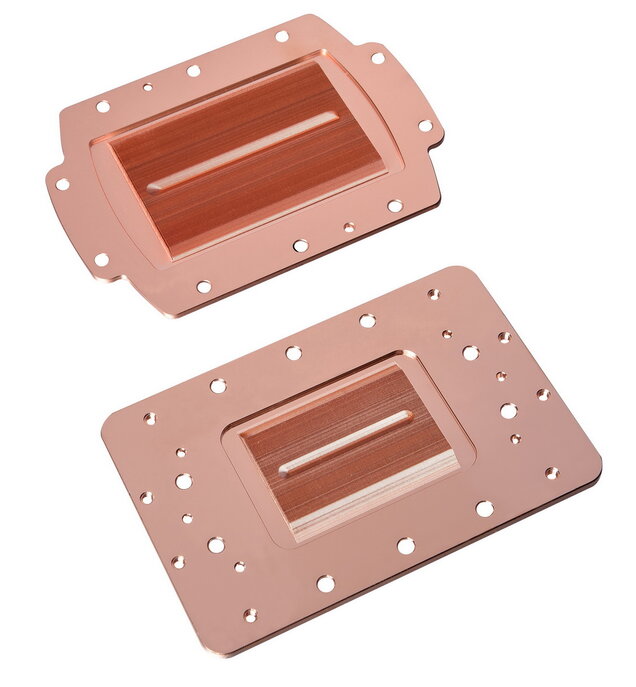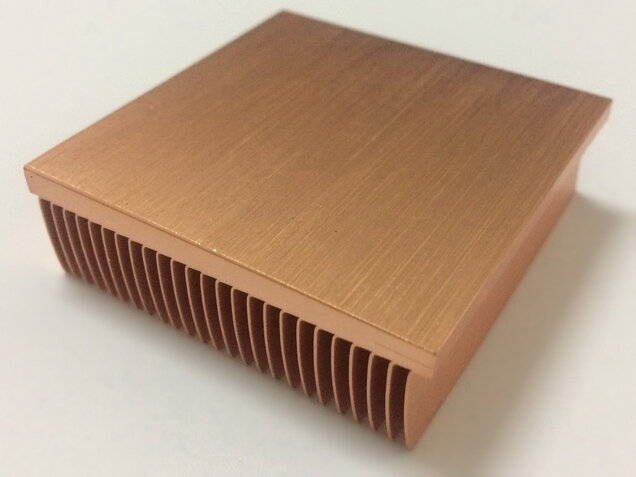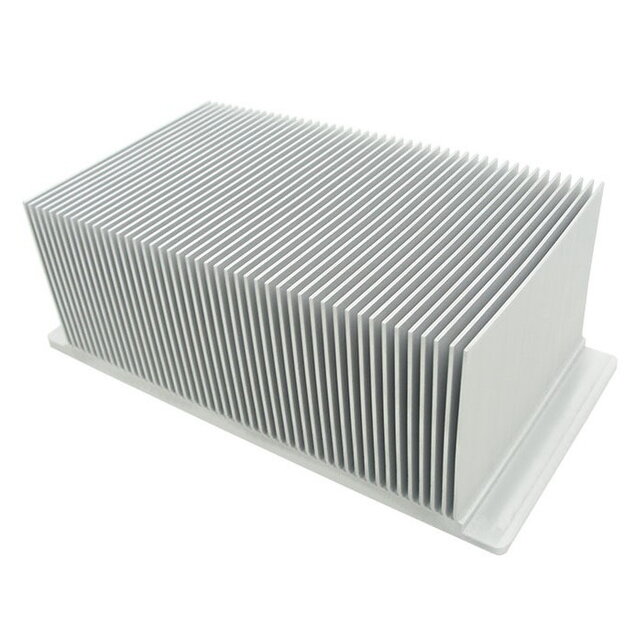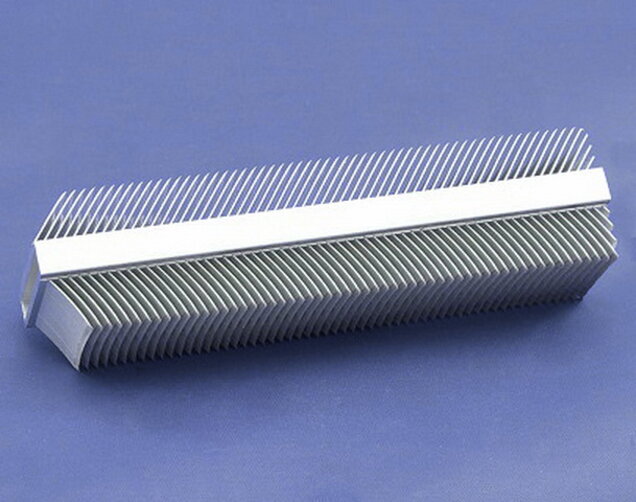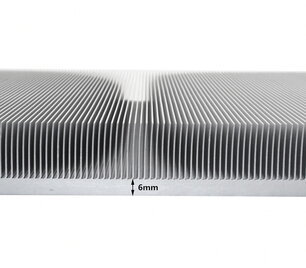
Heat Sinks Functionality
Heat sinks are used to reduce the heat generated when the equipment parts are running, thus the mechanical equipment components cooling to increase the operating life of the equipment. It is a layer of good heat conducting medium attached to heating equipment. So the quality of heat sink directly affects the service life of mechanical equipment. It acts as a kind of middleman, sometimes adding fans and other things to the heat-conducting medium (heat-conducting paste) to speed up the cooling effect. But sometimes heat sinks also act as bandits, such as in refrigerators where the heat is forced out to reach temperatures lower than room temperature.
Heat Sink Materials: Aluminum vs. Copper
1. Aluminum Heat Sinks
Aluminum is the most common material for heat sinks. In particular, extruded aluminum heat sinks fit the needs of most projects. The metal is lightweight and has relatively good thermal conductivity.
2. Copper Heat Sinks
Copper has even better thermal conductivity than aluminum. It’s drawbacks, though, are weight and cost. The metal is sometimes used where the importance of thermal conductivity outweighs weight savings.
1. Copper Skived fin heat sink:
Copper thermal conductivity is good, plus the skived fin technology can achieve the maximum heat dissipation area per unit volume, greatly improve the overall heat dissipation performance. Copper skived fin heat sink is used in high end chip, cpu heat dissipation, server and other fields
High speed skiving of copper CPU heat sinks
Skiving of fins of 0,08 mm or smaller
2. Aluminum skived fin heat sink:
Generally made of pure aluminum, thermal conductivity is higher than aluminum alloy, and with skiving technology, heat dissipation performance is more stable than aluminum extrusion heat sink. Aluminum skived heat sinks are widely used in photovoltaic industry, electric vehicles, inverters, led lights ,communication products and so on.
Aluminum heat sink
Aluminum profile is pure aluminum or aluminum alloy as raw material, Various aluminum alloys include 6061, 6105, 6005, 6063, 6060, 6101, 1100 and 1350 alloys. The aluminum alloy after smelting, cutting, extrusion and other processes can form different section shape of the metal panel. And then can be cast in drawing, grooving, grinding, deburring, sandblasting, electroplating, radium screen printing, anodizing and other surface treatment processes can be fine surface, making heat sink enclosure with superior performance.
Advantages of aluminium heat sink
As a raw material, aluminium heat sink has the following characteristics.
1. Lightweight
Aluminium is a light metal with a density of only 2.7g/cm, about a third that of steel and copper (7.85g/cm and 8.9g/cm). Therefore, it is used to make heat sink enclosure. The weight of aluminum profile is lighter under the same volume, and the light weight aluminium profile is put into production to make light and thin aluminium heat sink enclosure , which is very consistent with the current trend of the pursuit of light and thin products.
2. Corrosion resistance
The working environment of the heat sink is complex, and the selected raw materials will be able to pass the corrosion resistance. Aluminium can form a dense oxidation film on the surface to prevent further corrosion inside, and after surface treatment, the aluminium heat sink has better corrosion resistance. Therefore, aluminium profile with this point can be used in the actual standing, not in the later period because of metal corrosion and affect the aesthetic and thermal performance.
3. Thermal conductivity
Heat conduction and heat dissipation ability is one of the indispensable properties of heat sink. The thermal conductivity value of aluminium is 204/W·(m·k), but the hardness of pure aluminium is low, deformation is easy to occur when heated, and the pure aluminium into aluminum alloy can not only ensure excellent thermal conductivity, but also ensure the aluminium heat sink has a long service life.
Often can take copper and aluminium to compare when raw material in the industry, although copper is better than aluminium really on thermal conductivity property, but cannot realize lightweight body, also want higher than aluminium alloy on cost, because this aluminium profile heat sink is more popular on market.
4. The non-magnetic
Non - magnetic is also an important property of the heat sink enclosure. Among them, the heat sink enclosure put into audio and electronic products should be non-magnetic. In order to avoid interfering with the transmission of signals, while the aluminium alloy, which does not contain iron, cobalt, nickel and other metals, is not magnetic, so as not to interfere with the normal operation of audio and electronic products.
5. Plasticity
The specific tensile strength, yield strength, ductility and corresponding work-hardening rate of metals all affect the range of shape variables. So different metals have differences in plasticity, and aluminum alloy is easy to forge and has a high plasticity, which is widely used in industry.
Copper heat sink features
A copper heatsink is sometimes used as a heat sink as it has high thermal conductivity. This can be observed if you heat one end of a piece of copper, the other end will quickly reach the same temperature, Because copper's high thermal conductivity allows heat to pass through it quickly. So the heat dissipation capacity of copper heat sink is excellent, often heat absorption is fast, heat dissipation is also fast, heat dissipation capacity is stronger than aluminum material
The main features of copper being chosen as the material for the heat sink include:
- Copper has good heat conductively
- Thermal conductivity is 401 W/mk
- Desity is 8.9kg/m3 (0.321 lb/in³)
Aluminium heat sink features
An Aluminium heatsink is the most widely used product for thermal solutions. Aluminium (Aluminum) is the second most widely used metal in the world after Iron. After oxygen and silicon, aluminium is the most common element in the Earth’s crust. The properties that make a aluminium heatsink popular include:
- Good thermal and electrical conductivity
- Low density with a density ~ 2,700 kg/m3
- Low weight
- High strength of between 70 and 700 MPa
- Easy malleability
- Easy machining
- Excellent corrosion resistance
- non-magnetic which avoids interference of magnetic fields
- Easy to recycle
Compared with other metals, aluminium has a relatively large coefficient of linear expansion. Aluminium’s malleability is essential for the extrusion process, and in bending and other forming products.
An Aluminium heatsink is an excellent conductor of heat.
- A6061 has a thermal conductivity of ~ 167W/m-K and is typically used for machined heatsinks
- A6063 has a thermal conductivity of ~ 167W/m-K and is typically used for extruded and skived heatsinks
Although the thermal properties are less than copper, An aluminium heatsink weighs approximately half as much as a copper conductor having the same conductivity, and is also less expensive.
Aluminum reacts with oxygen in air to form an extremely thin layer of Aluminium Oxide. Anodizing increases the thickness of the oxide layer and improves the strength of the natural corrosion protection.
The Future of Heat Sink Materials
Heat sinks are like any other product in the always-advancing field of electronical power units and computers. Companies are constantly striving to find lighter, more conductive materials to make efficient heat sinks. They don't need to be made from just one material. For example, some heat sink producers are bonding copper and aluminum together. The design consists mainly of aluminum (for its lightweight properties) surrounded by a copper plate (for its high rate of thermal conductivity). These are great -- in theory -- but if the copper doesn't bonded tightly with the aluminum, which is often the case in inexpensive heat sinks, the copper plate can do more harm than good.
In 2008, the firm Applied Nanotech announced that the future of heat sinks is an isotropic material called CarbAl. CarbAl is made up of 20 percent aluminum and 80 percent of two different carbon-derived materials with excellent thermal conductivity. Everybody was excited about the material because it has a thermal conductivity of 425 W/mK (higher than both aluminum and copper) and has a density similar to aluminum. Basically, CarbAl is more conductive than copper and weighs the same as aluminum, making it the best of both worlds.
Another material that's gaining popularity with heat sink producers is a natural graphite composite material. It's not as conductive as copper, but it's close with a thermal conductivity of 370 W/mK. But the real advantage of graphite is its weight -- it weighs just 70 percent of the weight of aluminum.
